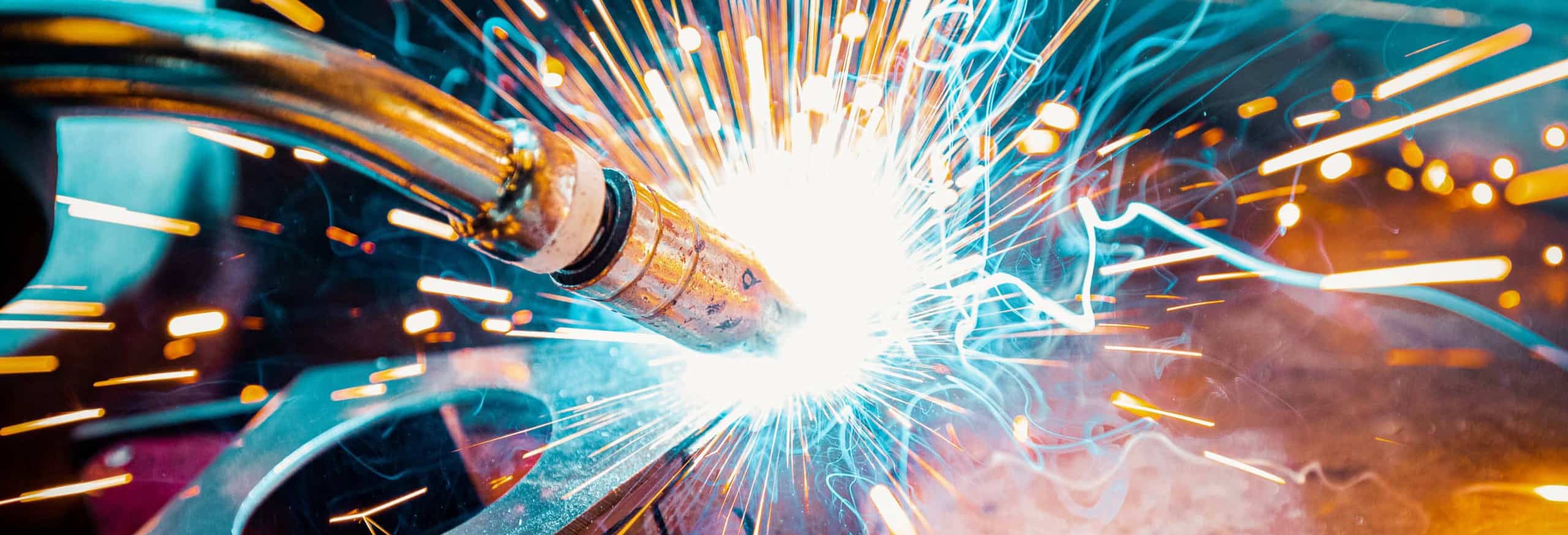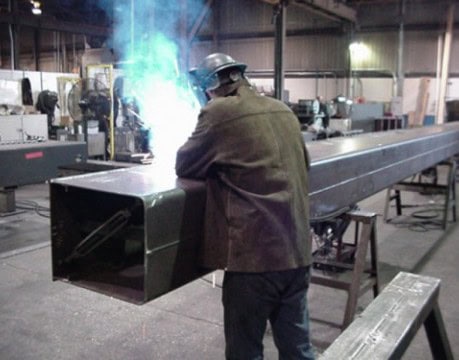Precision welding processes use carefully controlled heat and pressure to reliably fuse metal parts together and create durable joints. Welding is an ideal fabrication technique for assemblies that need inconspicuous weld lines or require close dimensional tolerances. Numerous precision welding methods are available to fulfill the needs of diverse projects, and each type offers its own unique advantages and drawbacks. Read on to learn more about the various types of precision welding, the pros and cons of welding techniques, and common applications.

Different Types of Welding Techniques
Depending on your application’s requirements, you can choose from numerous different types of welding techniques to generate reliable, high-quality welds.
Submerged Arc Welding (SAW)
A highly common welding technique, SAW creates an electrical arc between a workpiece and a continuously fed consumable electrode as well as a flux blanket. Producing welds of exceptional quality while decreasing the likelihood of distortion, this process is compatible with automation solutions, larger projects, and thick metals. However, it necessitates using specialized equipment, requires that you remove post-weld slag, and offers you limited visibility during the process.
Seam Welding
Instead of rods, this welding process utilizes wheels as electrodes to create a continuous seam in your assembly. Seam welding encompasses both friction and resistance seam welding. It’s advantageous for its ability to produce quick yet durable joints with minimal overlapping, heat distortion, and pollution. The process is a good choice for gas- or liquid-tight vessels, but it’s not the right option for metals exceeding 3mm in thickness. The specialized equipment capable of seam welding is also quite costly and requires a highly skilled operator.
Shielded Metal Arc Welding (SMAW)
Called simply arc welding and stick welding as well, the versatile SMAW method generates an electrical arc with a consumable electrode protected by a flux shield. The process doesn’t rely on shielding gas. Equipment for the SMAW technique is both portable and economical, and it’s well-suited to a range of material options as long as they aren’t too thin. However, the SMAW method is slowgoing, and the weld quality relies solely on your operator’s skill. You must also remove slag upon completion.
Gas Metal Arc Welding (GMAW)
Also referred to as metal inert gas (MIG) welding, GMAW shields an electrode of solid wire construction with an external gas supply to safeguard against reactive environmental conditions. Unlike SMAW, this technique is applicable for thinner metals — as long as they’re ferrous —and doesn’t require as high a degree of welding talent to generate welds of superior quality. Another of the advantages of MIG welding is that it allows for faster rates of deposition. With this technique, keep in mind that it does necessitate using a shielding gas, and you might experience wire-feeding complications.
Gas Tungsten Arc Welding (GTAW)
Also known as tungsten inert gas (TIG) welding, this technique protects its non-consumable electrode of tungsten material utilizing an inert shielding gas. The advantages of TIG welding include its ability to create precise, clean, and high-quality welds. Compared to some other welding techniques, it emits less fumes and smoke, and it also works well with a broad spectrum of metals and alloy materials. However, the process is time-intensive and requires a well-trained operator and costly equipment to achieve.
Flux Core Arc Welding (FCAW)
Best for thicker metals, FCAW protects the electrode with core-provided gas rather than external gas like MIG welding. It possesses a higher production factor than GTAW or SMAW methods, and FCAW is beneficial for its high rate of deposition and efficiency. That said, it’s less precise than GTAW and increases your risk of lack of fusion in your project. The process requires shielding gas to work, as well as slag removal post-weld. There are two types of flux core welding: One shielded with an inert gas and one that does not require gas.


Common Welding Applications
The benefits of welding lend it to applications across a wide range of industries, including:
- Aerospace. Precision welding allows operators to generate welds on air- and spacecraft parts, enabling them to achieve tight tolerances for mission-critical components.
- Agriculture. This sector requires rugged equipment, and welded components offer that durability as part of tractors, plows, harvesters, backhoes, balers, sprayers, and more.
- Construction. Precision welding is essential for creating structurally sound welded joints on steel I-beams, support pilings, railings, and general load-bearing components and equipment parts.
- Contract manufacturing. Both manufactured components and manufacturing equipment require precision welding to create lasting, industrial-strength bonds.
- Military. Precision welding is effective at providing assemblies for transport vehicles, trucks, vehicle components, communication tools, process armor kits, submarines, and ships.
- Mining. Examples of fabricated components and welded assemblies for mining equipment include elevators, mine cages and cars, conveyor belts, ore pass chutes, skips, and drifts.
 Precision Welding Services From G.E. Mathis Company
Precision Welding Services From G.E. Mathis Company
G.E. Mathis Company leverages over a century of extensive experience and multi-industry expertise to maximize customer success. At every stage of operations, we maintain the highest level of craftsmanship, product quality, and integrity for even the largest of welding projects. Our company is ISO 9001:2015 and AWS-D1.1 certified, and we have a Certified Welding Inspector (CWI) on our team to ensure consistent weld quality with some of the tightest tolerances in the industry.
Our precision welding processes incorporate computer numerical control (CNC) and automated welding systems for maximum efficiency and accuracy. We work with varied material grades and types ranging from stainless and carbon steel to aluminum and HARDOX® wearplate, creating lasting welds on products up to 50 feet in length and 12 feet in width.
Along with extensive precision welding techniques, our experienced technicians are fully adept at the following value-added services, which we handle in-house at our fully equipped, state-of-the-art facility:
- Custom metal fabrication
- CNC laser and plasma cutting
- CNC punching
- Press-brake forming
- Non-destructive testing (NDT) and dimensional inspections
- Kitting and packaging
- Production Part Approval Process (PPAP) at all levels
- First Article Inspection Report (FAIR)
- Capability Studies (Statistical Process Control)
- Conflict Minerals Reporting Template (CMRT)
- Galvanizing and painting
Offering turnkey service capabilities allows us to meet your expectations for quality products, shorter lead times, and competitive pricing. Contact us to learn more about our precision welding services, or request a quote today to discuss your metalworking needs.






 Precision Welding Services From G.E. Mathis Company
Precision Welding Services From G.E. Mathis Company







